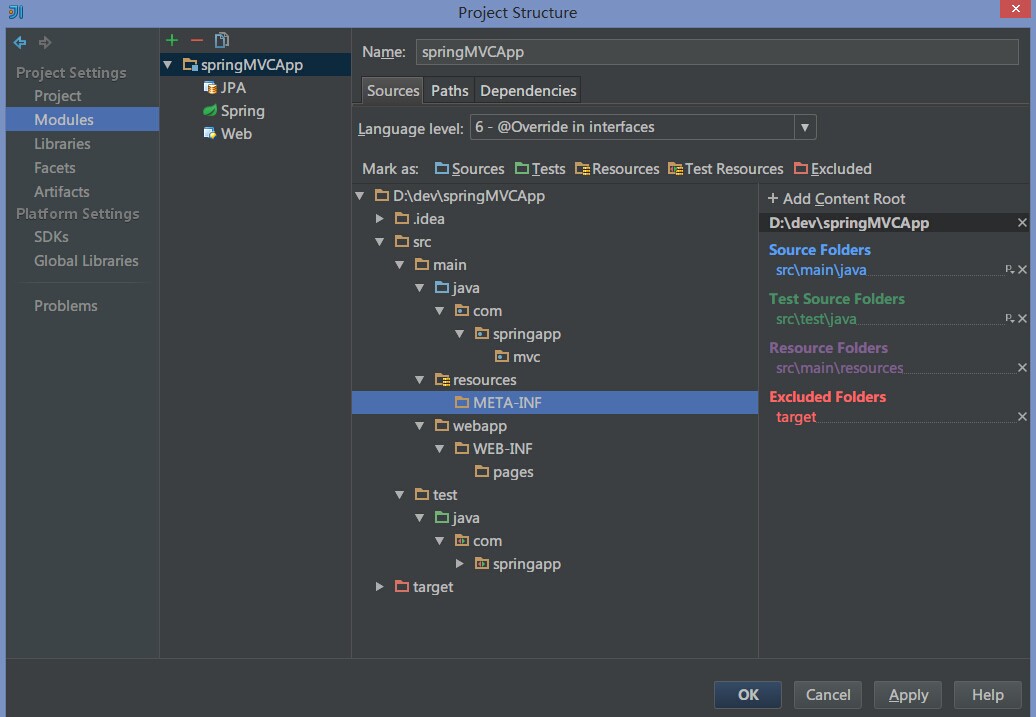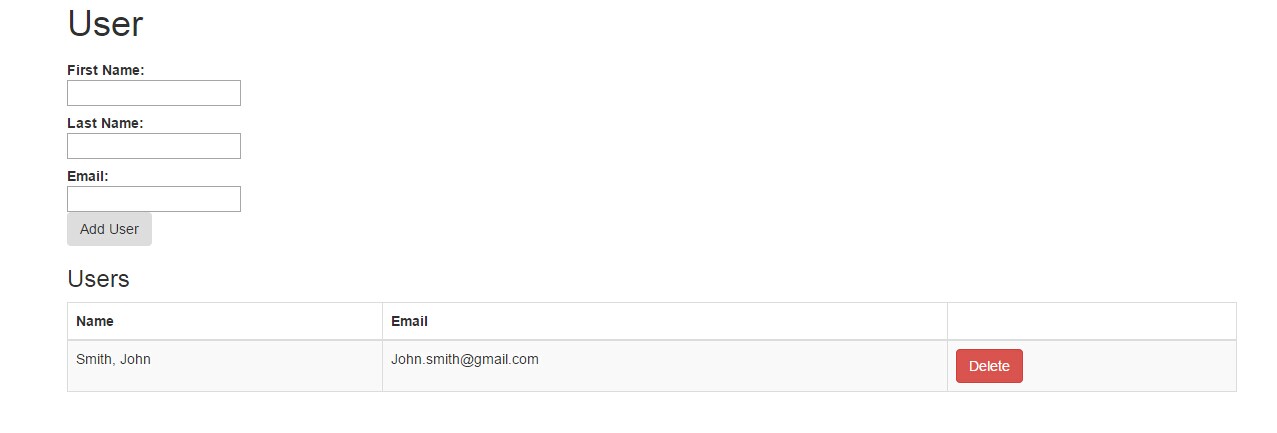最近把编辑器换成IntelliJ IDEA,主要是Eclipse中处理Maven项目很不方便,很早就听说IntelliJ IDEA的大名了,但是一直没机会试试。最近终于下载安装了,由于是新手,决定尝试个Tutorials,最终找了个熟悉点的项目,就是Getting Started with Spring MVC, Hibernate and JSON(http://confluence.jetbrains.com/display/IntelliJIDEA/Getting+Started+with+Spring+MVC%2C+Hibernate+and+JSON)。废话不多说了, 下面是我的实践过程:
在实践之前,有个问题首先要明确下,在IntelliJ IDEA中project相当于Eclipse中的workspace,module相当于Eclipse中的project。
1.创建Project。具体的过程我就不详述了,可以在官方的Tutorials中查看。下面是我的project structure截图

2.配置Tomcat,这步很简单,没什么可说的。配置完成后,将步骤1中建立的项目deployed到Tomcat上运行,等Tomcat启动完成后,就会启动你默认的浏览器,如果上面的步骤没什么错误的话,你就可以在你的浏览器中看到Hello World!了。
3.添加依赖。因为要使用数据库,Hibernate,JPA等。所以需要在pom文件中添加对应的依赖。等你添加完成后,IntelliJ IDEA会自动引入或下载所需的包。
4.接下来是创建持久化的配置文件。这个地方需要注意路径的问题。具体的路径可以查看project structure截图。这个配置文件中都是数据库的配置信息。数据库使用的是hsqldb,如果不想使用,可以改成自己想用的数据库,但是要注意修改相应的jar包。
<?xml version="1.0" encoding="UTF-8"?> <persistence version="2.0" xmlns="http://java.sun.com/xml/ns/persistence" xmlns:xsi="http://www.w3.org/2001/XMLSchema-instance" xsi:schemaLocation="http://java.sun.com/xml/ns/persistence http://java.sun.com/xml/ns/persistence/persistence_2_0.xsd"> <persistence-unit name="defaultPersistenceUnit" transaction-type="RESOURCE_LOCAL"> <provider>org.hibernate.ejb.HibernatePersistence</provider> <properties> <property name="hibernate.dialect" value="org.hibernate.dialect.HSQLDialect" /> <property name="hibernate.connection.url" value="jdbc:hsqldb:mem:spring" /> <property name="hibernate.connection.driver_class" value="org.hsqldb.jdbcDriver" /> <property name="hibernate.connection.username" value="sa" /> <property name="hibernate.connection.password" value="" /> <property name="hibernate.hbm2ddl.auto" value="create-drop" /> </properties> </persistence-unit> </persistence>
5.配置Model类,使用的技术为JPA。
package com.springapp.mvc;
import javax.persistence.*;
/**
* Created by yul on 2014/12/18.
*/
@Entity(name = "account")
public class User {
@Id
@GeneratedValue(strategy = GenerationType.AUTO)
private Long id;
@Basic
private String firstName;
@Basic
private String lastName;
@Basic
private String email;
public Long getId() {
return id;
}
public String getFirstName() {
return firstName;
}
public String getLastName() {
return lastName;
}
public String getEmail() {
return email;
}
public void setId(Long id) {
this.id = id;
}
public void setFirstName(String firstName) {
this.firstName = firstName;
}
public void setLastName(String lastName) {
this.lastName = lastName;
}
public void setEmail(String email) {
this.email = email;
}
}
定义service,这里官方的示例代码中没有@Repository注解,需要添加上
package com.springapp.mvc; import org.springframework.data.jpa.repository.JpaRepository; import org.springframework.stereotype.Repository; /** * Created by yul on 2014/12/18. */ @Repository public interface UserRepository extends JpaRepository<User, Long> { }
6.注册bean。包括repository, entity manager factory and transaction manager
<beans xmlns="http://www.springframework.org/schema/beans" xmlns:xsi="http://www.w3.org/2001/XMLSchema-instance" xmlns:context="http://www.springframework.org/schema/context" xmlns:jpa="http://www.springframework.org/schema/data/jpa" xmlns:tx="http://www.springframework.org/schema/tx" xsi:schemaLocation="http://www.springframework.org/schema/beans http://www.springframework.org/schema/beans/spring-beans.xsd http://www.springframework.org/schema/context http://www.springframework.org/schema/context/spring-context.xsd http://www.springframework.org/schema/data/jpa http://www.springframework.org/schema/data/jpa/spring-jpa.xsd http://www.springframework.org/schema/tx http://www.springframework.org/schema/tx/spring-tx.xsd"> <context:component-scan base-package="com.springapp.mvc"/> <jpa:repositories base-package="com.springapp.mvc" /> <bean id="entityManagerFactory" class="org.springframework.orm.jpa.LocalEntityManagerFactoryBean"> <property name="persistenceUnitName" value="defaultPersistenceUnit" /> </bean> <bean id="transactionManager" class="org.springframework.orm.jpa.JpaTransactionManager"> <property name="entityManagerFactory" ref="entityManagerFactory"/> </bean> <tx:annotation-driven transaction-manager="transactionManager"/> <bean class="org.springframework.web.servlet.view.InternalResourceViewResolver"> <property name="prefix" value="/WEB-INF/pages/"/> <property name="suffix" value=".jsp"/> </bean> </beans>
7.定义Controller。
package com.springapp.mvc; import org.json.JSONArray; import org.json.JSONException; import org.json.JSONObject; import org.springframework.beans.factory.annotation.Autowired; import org.springframework.stereotype.Controller; import org.springframework.ui.ModelMap; import org.springframework.validation.BindingResult; import org.springframework.web.bind.annotation.*; /** * Created by yul on 2014/12/18. */ @Controller public class UserController { @Autowired private UserRepository userRepository; @RequestMapping(value = "/", method = RequestMethod.GET) public String listUsers(ModelMap model) { model.addAttribute("user", new User()); model.addAttribute("users", userRepository.findAll()); return "users"; } @RequestMapping(value = "/add", method = RequestMethod.POST) public String addUser(@ModelAttribute("user")User user, BindingResult result) { userRepository.save(user); return "redirect:/"; } @RequestMapping(value = "/delete/{userId}") public String deleteUser(@PathVariable("userId") Long userId) { userRepository.delete(userRepository.findOne(userId)); return "redirect:/"; } @RequestMapping(value = "/api/users", method = RequestMethod.GET) public @ResponseBody String listUsersJson(ModelMap model) throws JSONException { JSONArray userArray = new JSONArray(); for (User user : userRepository.findAll()) { JSONObject userJSON = new JSONObject(); userJSON.put("id", user.getId()); userJSON.put("firstName", user.getFirstName()); userJSON.put("lastName", user.getLastName()); userJSON.put("email", user.getEmail()); userArray.put(userJSON); } return userArray.toString(); } }
我把后面返回JSON数据的方法也加上了。
8.定义view。官方提供的Bootstrap的CDN不好用,估计是GFW的问题,可以换成国内的。如果对于Bootstrap有兴趣,可以去这个网址http://www.bootcss.com/看看
<!doctype html> <%@taglib prefix="spring" uri="http://www.springframework.org/tags" %> <%@taglib prefix="form" uri="http://www.springframework.org/tags/form" %> <%@taglib prefix="c" uri="http://java.sun.com/jsp/jstl/core" %> <html> <head> <meta charset="utf-8"> <title>Spring MVC Application</title> <meta content="IE=edge, chrome=1" http-equiv="X-UA-COMPATIBLE"> <meta name="viewport" content="width=device-width, initial-scale=1.0"> <!-- 新 Bootstrap 核心 CSS 文件 --> <link rel="stylesheet" href="http://cdn.bootcss.com/bootstrap/3.3.0/css/bootstrap.min.css"> <%--<link href="http://twitter.github.io/bootstrap/assets/css/bootstrap.css" rel="stylesheet">--%> <%--<link href="http://twitter.github.io/bootstrap/assets/css/bootstrap-responsive.css" rel="stylesheet">--%> </head> <body> <div class="container"> <div class="row"> <div class="span8 offset2"> <h1>User</h1> <form:form method="post" action="add" commandName="user" class="form-horizontal"> <div class="control-group"> <form:label cssClass="control-label" path="firstName">First Name:</form:label> <div class="controls"> <form:input path="firstName" /> </div> </div> <div class="control-group"> <form:label cssClass="control-label" path="lastName">Last Name:</form:label> <div class="controls"> <form:input path="lastName" /> </div> </div> <div class="control-group"> <form:label cssClass="control-label" path="email">Email:</form:label> <div class="controls"> <form:input path="email" /> </div> </div> <div class="control-group"> <div class="controls"> <input type="submit" value="Add User" class="btn" /> </div> </div> </form:form> <c:if test="${!empty users}"> <h3>Users</h3> <table class="table table-bordered table-striped"> <thead> <tr> <th>Name</th> <th>Email</th> <th> </th> </tr> </thead> <tbody> <c:forEach items="${users}" var="user"> <tr> <td>${user.lastName}, ${user.firstName}</td> <td>${user.email}</td> <td> <form action="/delete/${user.id}" method="post"> <input type="submit" class="btn btn-danger btn-mini" value="Delete" /> </form> </td> </tr> </c:forEach> </tbody> </table> </c:if> </div> </div> </div> </body> </html>
到了这里,基本任务就算完成了。
下面就是测试了。在Tomcat中运行起你的项目。就可以在浏览器中看到效果了.

如果想查看返回的JSON数据。在浏览器中输入http://localhost:8080/api/users 即可。

